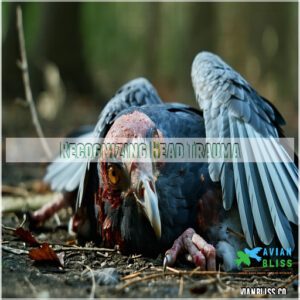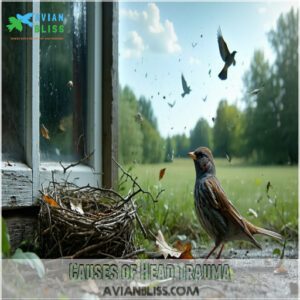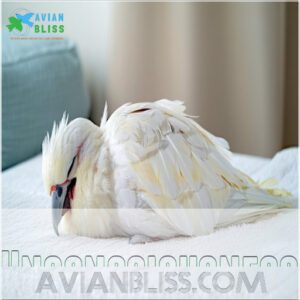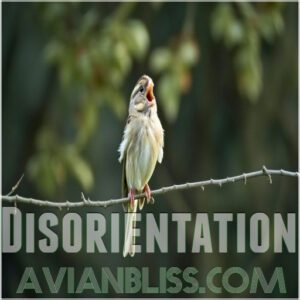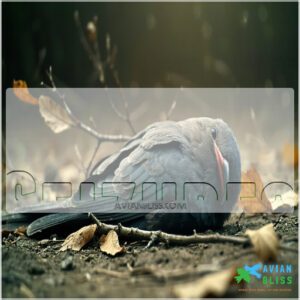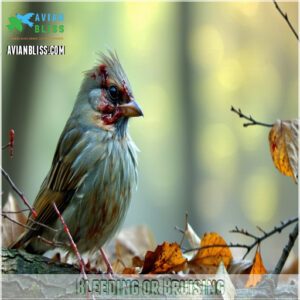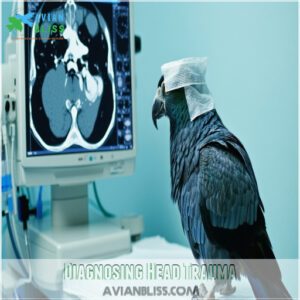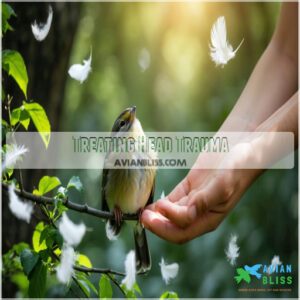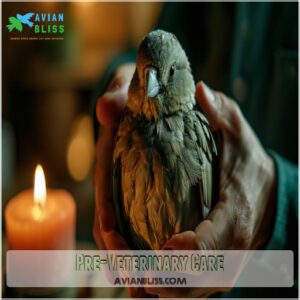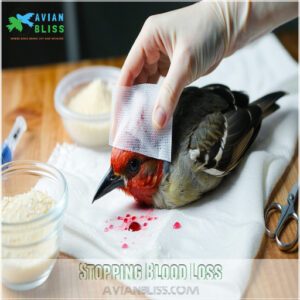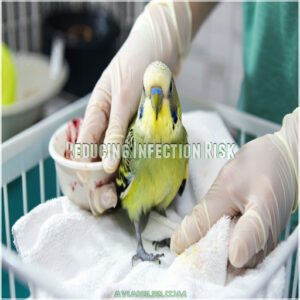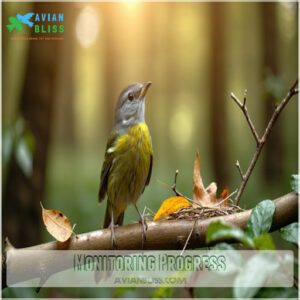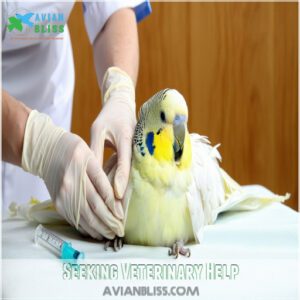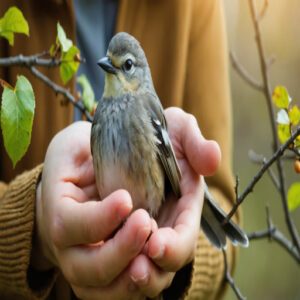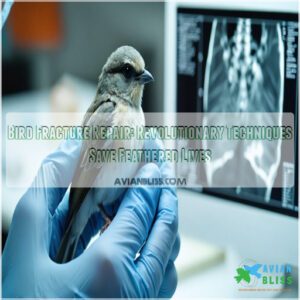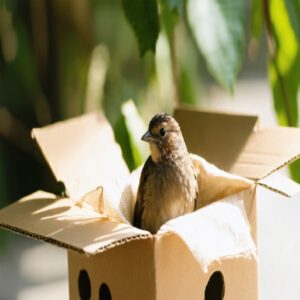This site is supported by our readers. We may earn a commission, at no cost to you, if you purchase through links.
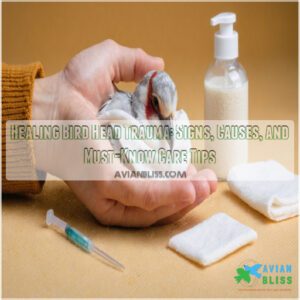
If there’s bleeding, apply light pressure with gauze, but avoid blocking its airway. Watch for symptoms like disorientation, wing droop, or difficulty perching—these often signal serious injuries.
Always seek veterinary care right away, as diagnosing head trauma may require X-rays or scans. Medications, fluids, or even surgery might be necessary.
At home, remove hazards like windows or ceiling fans to prevent future accidents. With care and attention, you’ll give your feathered friend the best chance at recovery.
Table Of Contents
- Key Takeaways
- Recognizing Head Trauma
- Causes of Head Trauma
- Symptoms of Head Trauma
- Diagnosing Head Trauma
- Treating Head Trauma
- Pre-Veterinary Care
- Natural Healing Process
- Preventing Head Trauma
- Managing Wounds
- Seeking Veterinary Help
- Frequently Asked Questions (FAQs)
- Can a bird survive a head trauma?
- What should I do if my bird has a head trauma?
- What is head trauma in birds?
- How long does it take a bird to recover from a head injury?
- What happens if a bird eats a head injury?
- How do you treat a bird’s brain injury?
- Can a bird recover from head trauma?
- How do you treat a traumatized bird?
- What to do if my bird hits his head?
- How long does it take for a bird to recover from shock?
- Conclusion
Key Takeaways
- Watch for symptoms like disorientation, difficulty perching, wing droop, and strange eye movements; these are often signs of serious head injuries needing immediate care.
- If your bird hits its head, keep it calm, warm, and in a quiet, dark space while avoiding handling and feeding; contact an avian vet right away.
- Prevent head trauma by removing hazards like windows, ceiling fans, and sharp toys, and always supervise playtime to avoid accidents.
- Quick actions like stopping bleeding, maintaining warmth, and monitoring breathing can stabilize your bird before veterinary help arrives.
Recognizing Head Trauma
Recognizing head trauma in birds is essential to their recovery and long-term health. You’ll need to watch for telltale signs like strange eye movements, unsteadiness, or drooping wings.
Strange Eye Movements
Strange eye movements, like eyerolling or erratic eye tracking, can signal serious issues, including eye injuries or nystagmus.
Watch for pupil changes or vision loss as these might hint at corneal or eyelid wounds.
Such shifts often stem from trauma, but addressing them promptly helps recovery.
Subtle signs like this shouldn’t be ignored—they’re your bird’s way of asking for care.
Difficulty Perching
Difficulty perching often signals head trauma in birds. Watch for:
- Struggling to balance or grip securely (balance issues).
- Drooping wings impacting perch support.
- Misaligned beak affecting perching stability.
- Resting on cage bottoms instead of perches (bird concussion symptoms).
- Weakness in one or both legs, hinting at wing strength or neurological damage.
Understanding the causes of head tilt issues is essential for effective diagnosis and treatment.
Prompt care aids in treating head trauma in birds.
Wing Droop
Wing droop often signals head trauma in birds, making it tricky for them to maneuver or even rest comfortably.
This visible sign, along with flight issues or feather damage, may stem from a wing injury caused by avian head trauma.
If your bird struggles with balance or keeps one wing lower, consider it a warning sign needing attention and possible droop recovery strategies.
Loss of Balance
A bird struggling with balance issues might show signs of loss of coordination or seem disoriented. They could stumble or even circle around awkwardly.
Watch for these symptoms:
- Dizzy spells leading to equilibrium loss.
- Stumbling birds unable to perch steadily.
- Head trauma symptoms like difficulty perching.
- Loss of coordination during walking or flying.
Take quick action if observed.
Causes of Head Trauma
Head trauma in birds can happen more often than you’d expect, and it’s usually tied to their environment or interactions.
Common causes include window strikes, fights with other birds, predator attacks, and falls from nests.
Window Strikes
Window strikes can lead to serious head trauma in birds, caused by their inability to see clear glass. These collisions may result in symptoms like disorientation, wing droop, or bleeding.
To boost bird safety, consider using window films or decals to make glass visible. Understanding avian vision and prioritizing collision prevention reduces risks of bird head wounds effectively.
Birds that experience window strikes often require immediate head injury care to prevent further complications.
Fights With Other Birds
Bird aggression often leads to head trauma in birds when flock dynamics unravel. Feeder fights and avian bullying can escalate quickly, causing beak injuries or bird head wounds.
If your bird suffers these injuries, separate it immediately to reduce stress.
Watch for signs of head trauma in birds like disorientation or bleeding.
Prevention includes monitoring interactions to avoid bird injuries.
Predator Attacks
A sudden predator attack, like hawk swoops or cat injuries, can lead to avian injuries, including bird head trauma. Wild predators often aim for the head or wings.
Protect your bird with these tips:
- Supervise outdoor time.
- Install netting or enclosures.
- Avoid attracting predators near the bird’s area.
- Keep predators away with bird defense methods.
Falls From Nests
Young birds can tumble from nests if the structure is weak or poorly built.
These falls often cause head trauma, leading to disorientation or worse.
Make sure safety by checking nest structure and placement. Support injured birds with warmth and avian first aid until veterinary help is available.
Recognizing symptoms of head trauma in birds, like lethargy or wing droop, is essential for recovery.
Symptoms of Head Trauma
Head trauma in birds can show up in surprising ways, from disorientation to seizures. You might also notice bleeding, bruising, or even unconsciousness, all of which need quick attention.
Unconsciousness
Unconsciousness in birds after head trauma is alarming and needs immediate attention. It’s a serious symptom of brain injury, often linked to a concussion or severe impact.
Keep the bird still and warm, avoiding any loud noises. Coma care starts with monitoring breathing and gently placing the bird in a quiet, safe spot.
Seek veterinary help immediately for proper trauma response and healing.
Disorientation
When a bird shows balance issues, circling, or loss of spatial awareness, it could be battling disorientation from head trauma.
Signs of concussion in birds might include clumsiness or resting awkwardly.
Dizziness symptoms, like unsteady perching, are common after impacts.
Coordination loss is also a red flag.
Watch closely, as disorientation signals deeper problems needing attention.
Seizures
Seizures in birds, often caused by brain injury or head trauma, are a serious sign needing immediate care.
Watch for these seizure symptoms:
- Uncontrolled shaking or convulsions.
- Sudden falls and stiff body movements.
- Inability to stand or balance during an epileptic fit.
- Erratic, repetitive motions.
Quick neurological care and convulsion treatment can help stabilize your feathered friend.
Bleeding or Bruising
Bleeding or bruising after head trauma can be scary, but it’s not uncommon. Blood loss from external wounds needs quick attention—gentle pressure can help with hemorrhage control.
Internal issues like cerebral hemorrhaging or bruises often indicate deeper injury. Proper wound care speeds up recovery and aids the trauma healing process.
Always monitor for signs needing concussion treatment or veterinary help.
Diagnosing Head Trauma
To diagnose head trauma in your bird, you’ll need a vet to assess their condition through a combination of history, physical exams, and advanced imaging like X-rays or CT scans. These steps help pinpoint the extent of the injury and guide the best course of treatment.
Veterinary History Taking
Understanding a bird’s medical history is key to proper care. Avian vets might ask essential questions to build a patient profile and guide treatment.
Expect questions like:
- What caused the injury?
- How has your bird behaved since?
- Any prior health issues?
- Were there environmental hazards?
- What did you observe immediately after the incident?
Physical Exam
During a physical exam, the vet evaluates your bird’s neurological responses, such as balance and coordination, to check for symptoms of head trauma.
They conduct physical examinations by examining eye movements, inspecting the beak for damage, and feeling the skull for abnormalities.
Feather condition can also provide clues about potential injuries.
This hands-on approach helps guide treatment for head trauma, aiding your bird’s recovery.
Radiographs
Radiographs are critical diagnostic tools for identifying fractures in birds, especially skull fractures caused by head trauma. X-ray images reveal details about the bird’s delicate skull structure and bone density, guiding treatment decisions. Proper imaging techniques guarantee accuracy, though sedation may be needed to reduce stress.
Radiographs help pinpoint bird head injuries, making them essential for understanding fractures in birds effectively. The diagnostic process often involves reviewing avian radiography techniques to guarantee the best possible outcomes for the bird.
CT Scans
A CT scan is a powerful diagnostic tool for bird head injuries. It helps identify skull fractures, internal bleeding, and brain injuries with precise image analysis.
Key benefits include:
- Detailed brain imaging for traumatic brain injury.
- Detecting fractures and subtle damage.
- Supporting head trauma recovery planning.
- Guiding head injury recovery and rehab decisions
Treating Head Trauma
Treating head trauma in birds requires quick action and proper care to support their recovery.
From medications to surgical intervention, each step guarantees your bird has the best chance to heal.
Medications
Medications can make a huge difference in your bird’s recovery. Pain relief and anti-inflammatories ease discomfort, while steroid use reduces swelling when prescribed cautiously by avian veterinary care.
Antibiotic therapy helps prevent infections from open wounds. Sedation methods may calm distressed birds during treatments or tests.
Trust a skilled bird vet to guarantee proper avian medicine customized to your bird’s health. Effective bird pain management often involves using bird pain relievers to improve recovery outcomes.
Fluids
Restoring hydration levels is critical for healing.
Fluid therapy counters blood loss, supports inflammation recovery, and boosts blood clotting and wound healing.
IV administration sustains proper electrolyte balance and maintains essential blood volume.
It’s like refilling a car’s gas tank—fluids power your bird’s recovery.
Always prioritize fluids early to stabilize health and promote healing from head trauma effectively.
Surgical Intervention
Sometimes, fluids alone can’t fix a head injury. Birds with severe brain injury, skull fractures, or beak damage may need surgical repair. Here’s how vets address this:
- Craniotomy clears pressure from swollen brain tissue.
- Orthopedic Fixation stabilizes fractured bones for proper healing.
- Beak Surgery trims jagged edges, helping fracture healing and preventing infection.
Physical Therapy
Once your bird stabilizes after head injury treatment, trauma recovery time involves gentle exercises to regain strength and coordination. Simple balance training, wing rehabilitation, and mobility therapy help rebuild movement.
Strength building, like encouraging controlled stretching, supports healing from trauma. Patience is key during bird rehabilitation, as brain injury rehab takes time. Always follow your vet’s guidelines when exercising.
Pre-Veterinary Care
Before you can get a bird with head trauma to a vet, it’s imperative to stabilize them and keep them comfortable.
Simple steps like maintaining warmth, handling them gently, and monitoring their breathing can make all the difference.
Transporting The Bird
Carefully transporting an injured bird can make all the difference in its recovery.
Use a secure bird carrier with ventilation, keeping the inside dark to reduce stress.
Creating a safe environment is important for recovery. Support the bird’s head gently to avoid further harm.
Providing basic care includes offering water and a safe, temporary shelter.
- Show love: Speak softly—they’ll feel your care.
- Stay steady: Minimize sudden movements.
- Think ahead: Notify the wildlife rehabilitation center.
Maintaining Warmth
To aid healing bird brain injuries, maintain warmth effectively. Use warm towels or an insulated carrier to stabilize body temperature.
Maintain room warmth stays consistent, but avoid overheating. Gentle heat sources like a heating pad (on low) can help, especially during transport to the avian vet.
Proper temperature control boosts bird health and supports first aid before veterinary care begins.
For ideal healing, understanding thermal heating pad benefits is essential in maintaining the right temperature.
Monitoring Breathing
Watch for changes in your bird’s respiratory rate or unusual breathing patterns, like open-mouth breathing or gasping. These could signal airway obstruction or reduced oxygen levels from head trauma.
Make sure the bird stays calm in a well-ventilated space.
Monitoring breathing helps catch critical symptoms of head trauma in birds early, supporting their brain healing process and recovery.
Handling The Bird
Keep your bird calm and supported to avoid worsening injuries. When handling stressed birds, use slow movements to reduce fear. Support its body and head gently in a horizontal position.
For safe transport:
- Use a lined carrier to cushion movement.
- Keep it dark and warm for stabilization.
- Contact a wildlife rehabilitation center immediately for guidance.
Natural Healing Process
Your bird’s body has an incredible ability to heal itself after head trauma through natural processes.
From reducing bleeding to regenerating damaged cells, these steps work together to repair injuries over time.
Blood Vessel Constriction
After a bird head injury, blood vessel constriction plays a big role in trauma response. It helps manage bleeding and kickstarts wound healing by reducing blood flow to injured areas. This lowers the risk of cerebral hemorrhaging and supports blood clotting.
Vessel repair begins as tissues stabilize, aiding trauma recovery time and improving injury management, even with concussions in birds.
Inflammation
Inflammation kickstarts a bird’s natural healing by increasing blood flow to the injury.
This inflammatory response brings immune cells to combat infection and start tissue repair.
You might notice swelling, which helps protect damaged cells while healing begins.
Pain management is key to keep your bird comfortable as inflammation works alongside swelling reduction to restore balance and promote recovery effectively.
Cell Regeneration
Once inflammation kick-starts the process, cell regeneration becomes the star of healing. Cell regeneration is essential for rebuilding damaged areas through tissue repair, relying on stem cells and neural regeneration. This natural healing process works like tiny architects, efficiently and precisely reconstructing the body’s framework for wound healing.
Scar Tissue Formation
Scar tissue forms during a bird’s natural healing as collagen production accelerates to repair wounds. This fibrosis process strengthens damaged areas, aiding brain damage repair.
You’ll notice wound closure as healing progresses, though scar reduction depends on health and care.
Watch for these steps:
- Increased collagen builds tissue.
- Fibroblasts assist tissue repair.
- Scars shrink.
- Regeneration completes healing.
Preventing Head Trauma
You can prevent distressing head injuries in your feathered friend by removing hazards like ceiling fans and installing window decals to prevent collisions.
You’ll also need to inspect toys regularly for wear and tear.
While making sure birds of different sizes are separated to create a safe environment for your pet.
Removing Hazards
While your bird’s natural healing abilities are remarkable, creating a safe environment prevents injuries before they occur.
Start by installing window guards or decals to prevent strikes. Keep mirrors covered, secure loose wires, and check for gaps between cage bars.
You’ll also want to place protective netting over open windows to block potential predator access. Remove ceiling fans from rooms where your bird flies freely.
Supervising Playtime
Keeping a watchful eye during playtime isn’t just about preventing accidents—it’s essential for bird welfare.
Always supervise your feathered friend’s activities, especially in new play areas. Watch for signs of fatigue or aggressive bird behavior that could lead to head injuries.
Create designated safe zones away from environmental hazards, and never leave birds unsupervised when they’re exploring or playing with each other.
By understanding the importance of preventing feather damage, owners can take proactive steps to promote their birds’ overall health and well-being.
Inspecting Toys
Look through your bird’s toys during weekly Toy Safety Checks to prevent head trauma.
Examine each item for Broken Toy Risks and Sharp Edge Detection that could harm your feathered friend.
Run your fingers along ropes to spot fraying, and test toy materials for loose parts.
Birds’ delicate anatomy makes them susceptible to concussions, so replace damaged items immediately – it’s better to toss a questionable toy than risk injury.
Separating Birds
Regularly separating birds of different sizes prevents accidental head trauma during social interactions.
When managing flock dynamics, create designated spaces using cage division techniques to keep larger birds away from smaller ones, especially during recovery from concussions.
Bird isolation isn’t permanent – it’s a temporary safety measure your avian friend needs while healing.
Consider using a wildlife rehabilitation center for professional guidance on proper separation techniques.
Managing Wounds
When a bird sustains a head wound, it’s essential to act quickly to stop any bleeding and protect the injury.
Proper care can minimize infection risk and give your bird the best chance for a full recovery.
Stopping Blood Loss
Stop bleeding by gently applying pressure with a clean gauze square or cloth. Avoid touching the bird’s nares or restricting breathing.
For minor wounds, use cornstarch to encourage blood clotting.
Quick action in hemostasis methods is vital for emergency care, especially after head trauma in animals or bird brain damage. Keep the bird calm to prevent stress and further trauma.
Promoting Healing
Healing a bird’s head trauma requires patience and care. Focus on promoting recovery with simple steps:
- Nutrition therapy boosts energy for healing bird brain injuries.
- Stress reduction creates a calm, cozy space.
- Gentle pain management helps improve comfort.
- Wound cleaning prevents complications.
- Try rehabilitation exercises once stable for mobility.
Veterinary care makes sure progress while supporting cell regeneration post-concussion. Effective bird first aid techniques are essential for a successful recovery.
Reducing Infection Risk
Clean the wound gently with warm water or a saline solution to remove contamination.
Use sterilization techniques, like disinfected tools, to avoid introducing bacteria.
Antibiotic use should follow an avian vet’s guidance for effective infection control.
Promote bird hygiene by keeping the cage spotless.
Infection can escalate quickly, so prioritize bird first aid and seek veterinary care if signs worsen.
Monitoring Progress
Tracking your bird’s progress during recovery is essential. Watch closely for key signs of improvement and any red flags in their trauma response. Here’s what to monitor:
- Bird Behavior: Look for steadier perching or flying.
- Recovery Signs: Reduced head tilt or lethargy.
- Healing Stages: Gradual wound closure.
- Balance: Improved coordination.
- Energy Levels: Increased activity.
Seeking Veterinary Help
If your bird shows signs of head trauma, knowing when to contact a vet can make all the difference.
Acting quickly and following clear steps guarantees your pet gets the care it needs to recover.
Identifying Severity
Understanding trauma levels in birds is key for injury assessment. Examine for bird skull fractures, bleeding, strange eye movements, or unresponsiveness.
Severity scores help classify the head injury, from mild to severe. A swollen head or disorientation often signals a concussion in birds.
Assess any traumatic head injury carefully before seeking a diagnosis of head trauma from a veterinarian.
Recognizing Emergency Signs
In emergencies, knowing your bird’s behavior is paramount. Look for unusual signs like a head tilt, circling, strange eye movements, or wing droop.
A depressed or unresponsive bird needs immediate critical care.
Sudden trauma responses, like disorientation or seizures, are serious emergency symptoms.
Contact your vet immediately if head injuries or worsening conditions make the situation critical.
Providing First Aid
In an emergency, providing first aid for birds requires quick action.
First, make sure bird stabilization by placing it in a quiet, dark space.
Next:
- Gently clean visible wounds (avoid excessive pressure) to prevent infection.
- Stop bleeding using gauze or cornflour.
- Assess trauma quickly without handling excessively—head injuries demand prompt veterinary care for birds.
When dealing with bird head trauma, it’s essential to understand the importance of seeking avian vet emergency services.
Stay calm; your first response matters.
Following Veterinary Advice
Follow your avian vet’s advice carefully—your bird‘s recovery depends on it.
Veterinary guidance includes medication scheduling, follow-up visits, and creating a stress-free environment.
Stick to the post care tips provided, like supervising activity and monitoring for changes.
Medical compliance guarantees proper healing.
For any unusual symptoms, contact veterinary assistance immediately.
With your owner support, veterinary care will help your bird bounce back!
Frequently Asked Questions (FAQs)
Can a bird survive a head trauma?
A bird’s resilience is like a tree bending in the wind—it can survive head trauma, but quick action’s key.
Stabilize it, minimize stress, and seek avian veterinary care to assure the best possible recovery.
What should I do if my bird has a head trauma?
If your bird shows signs of head trauma, gently move it to a quiet, dark, warm space. Keep handling minimal.
Contact an avian vet immediately for guidance, and avoid feeding until evaluated.
What is head trauma in birds?
Head trauma in birds happens when they hit their head or face injuries, leading to symptoms like balance issues, unusual eye movements, or lethargy.
It affects their coordination, safety, and behavior, needing careful attention.
How long does it take a bird to recover from a head injury?
Time heals all wounds, but for a bird’s head trauma, recovery can take 1-4 weeks.
It depends on severity and care.
Keep the bird rested, warm, and under vet guidance to make sure proper healing.
What happens if a bird eats a head injury?
If a bird "eats" a head injury, it might indicate self-preening or stress.
Birds often peck at injuries, which can worsen healing.
Prevent access to the wound, consult a vet, and make sure a safe environment.
How do you treat a bird’s brain injury?
Picture a tiny feathered friend, dazed and wobbling.
Keep them calm in a quiet, dark space.
Support warmth and hydration.
Avoid handling too much, stabilize gently, and rush them to an avian vet immediately for care.
Can a bird recover from head trauma?
Yes, birds can recover from head trauma with proper care.
Quick action, like keeping them calm, warm, and seeking a vet, boosts their chances.
Recovery depends on the injury’s severity and timely treatment.
How do you treat a traumatized bird?
Your bird’s world may feel upside down, but act fast.
Gently place them in a quiet, dark space for calm.
Keep them warm, avoid feeding, and contact an avian vet immediately for expert care.
What to do if my bird hits his head?
Gently place your bird in a dark, quiet, and warm space to minimize stress.
Watch for unusual symptoms like bleeding, disorientation, or lethargy.
Avoid feeding and call an avian vet immediately for further guidance.
How long does it take for a bird to recover from shock?
Shock recovery in birds varies, but you’ll typically see improvement within a few hours to a day.
Keep your bird warm, secure, and in a quiet space while monitoring for signs of distress.
Conclusion
Quick, calm, and consistent care provides a bird’s best recovery from head trauma. Recognizing signs like disorientation or difficulty perching helps you act fast.
Causes like window strikes or falls are common, but prevention through hazard removal is key. Don’t delay seeking veterinary help for proper diagnosis and treatment.
Healing bird head trauma takes patience and attention, but your effort can make all the difference. Protecting your feathered friend starts by prioritizing their safety and well-being.
- https://be.chewy.com/medical-conditions-pet-bird-head-injury/
- https://corvid-isle.co.uk/first-aid-birds-impact-trauma
- https://www.cockatiel-advice-101.com/parrot-first-aid
- https://www.pigeons.biz/threads/fallen-fledgling-with-head-trauma.122670/
- https://www.msdvetmanual.com/exotic-and-laboratory-animals/pet-birds/traumatic-injury-of-pet-birds

